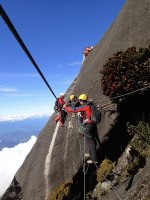Unclear how much of this is due to UV (so of less concern to cavers) & how much is due to grit damaging the fibres - but comparative tests with same harnesses used for climbing should make that clearer (chart is for the two harnesses shown).



As studies from France have shown, older canyoning harnesses have an increased safety risk, as the strength of the harness material has decreased significantly through use.
The strength values according to the standard (>15kN) were clearly undercut and in some cases were even below 300dN.
Attached are also photos of two harnesses which I had tested at Mammut according to the standard and which had much too low strength values although they were still in good condition.
Click on the link below for the full report in French on the tests:
https://www.yumpu.com/fr/document/view/63114591/rapport-harnais-canyonv4







